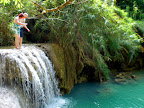Although we also visited these places while in Phnom Penn I felt they deserved a separate section. Before arriving in Cambodia I knew very little of its dark history involving Pol Pot and Khmer Rouge. The whole day turned out to be a very haunting and emotional day, as we were shown, sometimes in graphic detail, the atrocities that occurred during the dictatorship.
The first place we visited was the Killing Fields. This is where large amounts of the victims were taken to be tortured and killed. It is now exists as a memorial, and the first sight is the large stupa at the entrance which contains over 8000 mangled skulls of the people found buried at the site.
We slowly walked around the area, stopping for signs such as how many people were found buried in a certain pit, how people were executed and where they were detained. It was very moving, we were told that at the peak of the executions over 300 people a day were murdered, there were speakers fixed to all the trees which used to play loud music in order to cover up the sounds of the people being tortured and killed.
After a very sobering couple of hours we were taken to S21. If I thought the killing fields were bad that was nothing to our next experience. S21 was where Cambodians were detained and tortured before being executed. One of the first shocking things I discovered was it was run by child guards mostly between the ages of 12 and 18. They were taught to torture the countless Cambodians who were suspected of rebelling against the revolution – even just in thought. Confessing would not save your life. During Pol Pot’s reign most of the intellectuals of the country were killed, as they were perceived as a threat to the Khmer Rouge ideology. As the regime failed more and more working class and peasants were killed in a desperate effort to validate his attempts in building a communist society.
The school had been left frighteningly untouched since the regime. In the grounds there were signs displaying the rules of the camp, in the original Khmer, French and for the tourists now in English, such as “if you contest the guards in anyway you shall receive 10 lashes or 5 electric discharges”. The school was on several levels, the first level had rooms where they would detain individuals for torture, and inside each of these rooms was the original bed, the implements found in the room – and the most shocking of all a picture of the last victim that was discovered on each bed. These were very graphic and incredibly disturbing. We walked into each room, I found each and everyone very distressing and upsetting.
The next 2 floors contained a mixture of these torture rooms, rooms where they would detained up to 50 people, all shackled to the floor, and tiny holding cells which were barely big enough to sit in and had no light. A morbid juxtaposition in all of these places was there was still much evidence of it once being a school with lessons still written on the walls and classroom numbers still hanging.
In the second block of the school there was a gallery with all the photos of all of those that had been detained at S21. There were hundreds and hundreds of people all who looked emotionally weary, bewildered and so incredibly sad. In addition to the photos was a collection of paintings depicting the tortures and conditions, these were painted by one of the few survivors. To make the paintings more provocative some of the same torture devices were placed in and around the pictures, giving you a glaringly harsh reality to what you were observing.
We were shown pictures of the guards, what age they were when they joined the Khmer Rouge and the fact that most of them now just live ordinary lives, this was surprising and difficult to see, and made me think extensively of the situation Cambodia is now in. To think that so many people alive now remember very vividly the regime also does credit to the way in which Cambodians are now trying to move forward and build their country from this very dark time.
The whole day was a very humbling and sobering time, and I did not expect the atrocities I saw, especially as all of this happened in the 70’s! I could not believe things like this still happened in the modern world, and hoped this would be the only time on my trip that I was enlightened like this in such a horrible way, and although a harrowing day I am very glad to have gone to be able to respect the memory of the many victims.
Subscribe to:
Post Comments (Atom)

 Manchester
Manchester


No comments:
Post a Comment